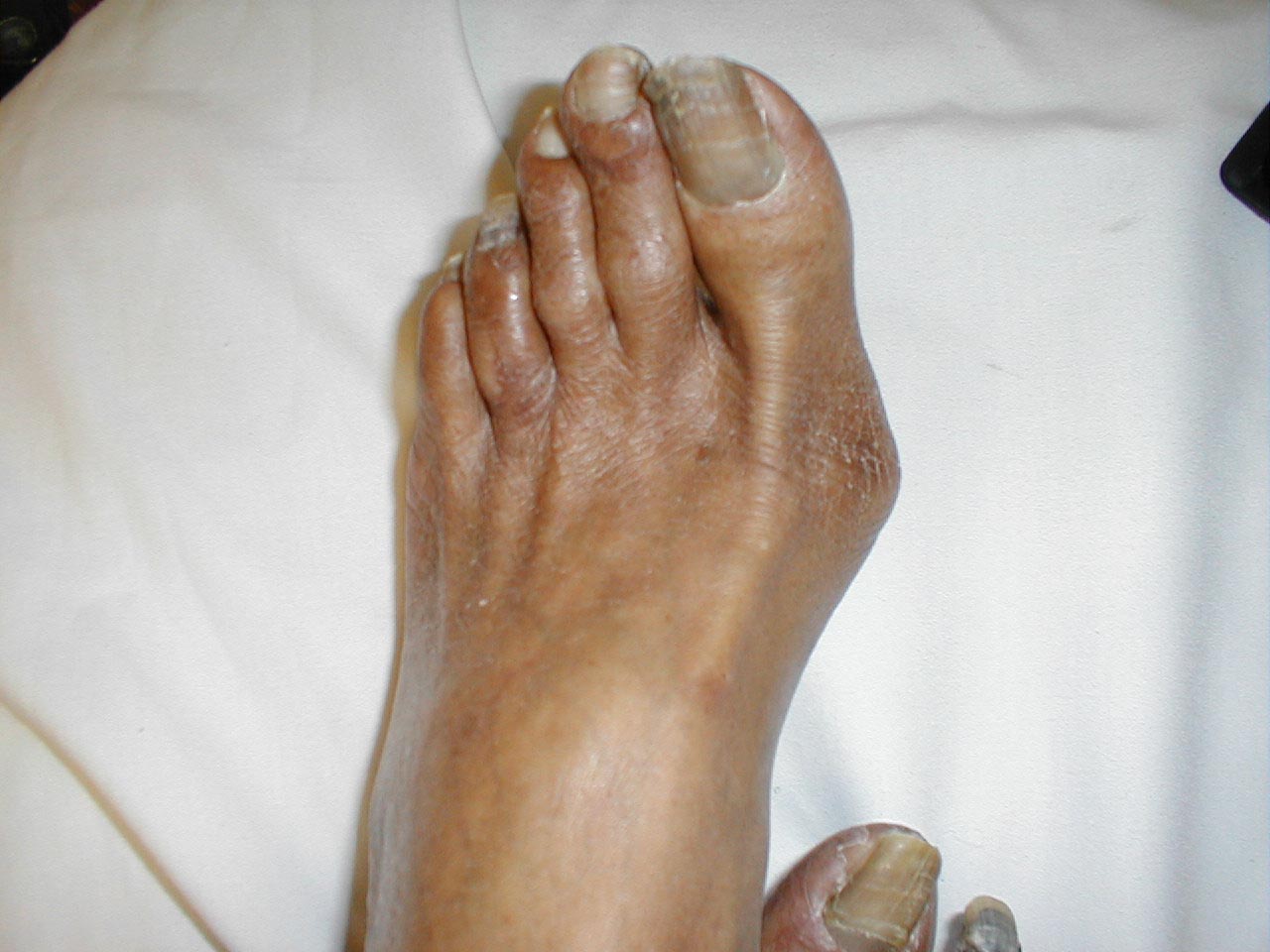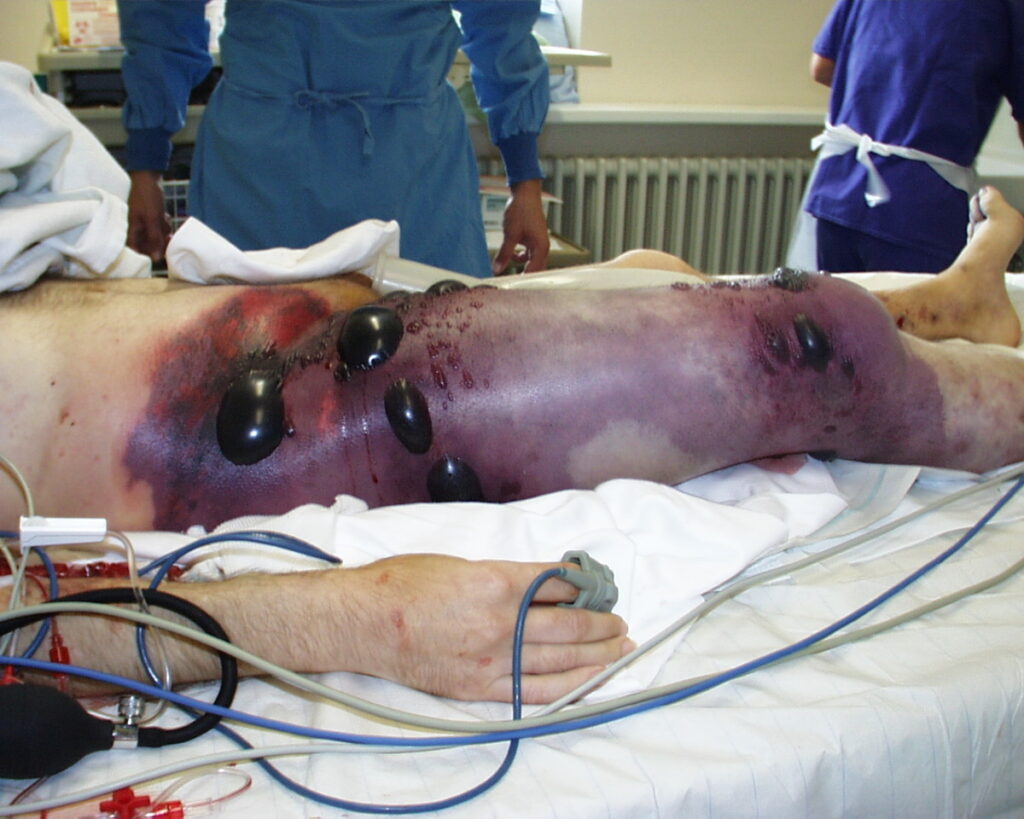Gangrene is a serious medical condition that occurs when body tissue dies due to a lack of blood supply or a severe bacterial infection. It can affect the skin, muscles, and internal organs, and if left untreated, it can lead to life-threatening complications. Understanding the types, causes, symptoms, and treatment options for gangrene is crucial for early detection and effective management. In this article, we will explore these aspects in detail.

What is Gangrene?
Gangrene refers to the death of body tissue caused by a lack of blood flow or a serious bacterial infection. When blood flow is interrupted, oxygen and nutrients cannot reach the affected area, leading to tissue decay. This condition often affects the extremities, such as fingers, toes, hands, and feet, but it can also occur in muscles and internal organs.
How Does Gangrene Develop?
Gangrene typically develops in areas where blood flow is restricted or completely blocked. This can happen due to various factors, including injuries, chronic diseases, or infections. Once the blood supply is cut off, the affected tissue begins to deteriorate, and bacteria may invade the area, worsening the condition.
Types of Gangrene
There are several types of gangrene, each with distinct characteristics and underlying causes. Below, we will discuss the most common forms of gangrene.
Dry Gangrene
Dry gangrene occurs when there is a gradual reduction in blood flow to a specific area. This type of gangrene is often associated with conditions like diabetes, atherosclerosis, or peripheral artery disease. The affected tissue becomes dry, shriveled, and dark in color, usually turning black or brown.
- Commonly affects extremities like toes and fingers.
- Progresses slowly compared to other types.
- No significant infection or pus formation.
Wet Gangrene
Wet gangrene occurs when there is an infection in the affected tissue along with a loss of blood supply. This type of gangrene spreads quickly and is considered more dangerous than dry gangrene. The presence of bacteria leads to the production of toxins, which can cause systemic illness and sepsis if not treated promptly.
- Characterized by swelling, blistering, and a foul-smelling discharge.
- Requires immediate medical attention to prevent complications.
- Often results from injuries, burns, or frostbite.
Gas Gangrene
Gas gangrene is a rare but severe form of gangrene caused by a bacterial infection, typically involving Clostridium species. These bacteria thrive in environments with low oxygen levels, such as damaged tissues. As they multiply, they release gas, which accumulates under the skin, causing a crackling sensation when touched.
- Associated with deep wounds or surgical incisions.
- Causes rapid tissue destruction and systemic toxicity.
- Requires emergency treatment to prevent fatality.
Fournier’s Gangrene
Fournier’s gangrene is a type of wet gangrene that specifically affects the genital area. It is more common in men and is often caused by an infection that spreads from the urinary tract or reproductive organs. This condition is life-threatening and requires immediate surgical intervention.
- Characterized by severe pain, swelling, and discoloration in the genital region.
- Can result from urinary tract infections or trauma.
- High mortality rate if not treated promptly.
Internal Gangrene
Internal gangrene occurs when the blood supply to an internal organ is compromised. This type of gangrene is less visible than other forms but equally dangerous. Common organs affected include the intestines, gallbladder, and appendix.
- May result from conditions like hernias or blood clots.
- Symptoms include fever, severe abdominal pain, and nausea.
- Requires urgent medical evaluation and treatment.
Causes of Gangrene
Gangrene can develop due to a variety of factors, ranging from chronic health conditions to traumatic injuries. Understanding the underlying causes is essential for prevention and early intervention.
Reduced Blood Flow
One of the primary causes of gangrene is reduced blood flow to a specific area. Conditions such as atherosclerosis, diabetes, and peripheral artery disease can narrow or block blood vessels, preventing oxygen and nutrients from reaching the tissues.
Infections
Bacterial infections can also lead to gangrene, particularly wet gangrene and gas gangrene. When bacteria invade damaged tissue, they release toxins that accelerate tissue death and spread the infection to surrounding areas.
Trauma and Injuries
Severe injuries, burns, or frostbite can damage blood vessels and tissues, increasing the risk of gangrene. Open wounds are particularly vulnerable to infection, which can progress to gangrene if not properly treated.
Surgical Complications
In some cases, gangrene can develop after surgery if blood flow to the surgical site is compromised or if an infection occurs. This is especially true for procedures involving the gastrointestinal tract or blood vessels.
Underlying Health Conditions
Certain chronic conditions, such as diabetes, obesity, and immune system disorders, increase the risk of developing gangrene. These conditions can impair circulation and weaken the body’s ability to fight infections.
Symptoms of Gangrene
The symptoms of gangrene vary depending on the type and location of the affected tissue. However, there are some common signs that indicate the presence of gangrene.
Changes in Skin Color
One of the earliest signs of gangrene is a change in skin color. The affected area may appear pale, blue, purple, or black, depending on the severity of tissue damage.
Pain and Numbness
As blood flow diminishes, individuals may experience pain followed by numbness in the affected area. This occurs because nerve cells are deprived of oxygen and nutrients.
Swelling and Blisters
In cases of wet gangrene, the affected area may become swollen, and blisters filled with fluid may form. These blisters can rupture, releasing a foul-smelling discharge.
Fever and Rapid Heart Rate
If gangrene is accompanied by an infection, individuals may develop a fever, chills, and a rapid heart rate. These symptoms indicate that the infection is spreading throughout the body.
Crackling Sensation
Gas gangrene is characterized by a crackling sensation when the affected area is touched. This occurs due to the accumulation of gas produced by bacteria beneath the skin.
Treatment Options for Gangrene
Treatment for gangrene depends on the type, severity, and location of the condition. Early diagnosis and intervention are critical to preventing complications and preserving healthy tissue.
Surgical Intervention
Surgery is often required to remove dead tissue and prevent the spread of infection. This procedure, known as debridement, involves cutting away damaged or infected tissue to promote healing.
- Amputation may be necessary in severe cases to save the patient’s life.
- Reconstructive surgery may be performed after debridement to restore function.
Antibiotics
In cases of wet gangrene or gas gangrene, antibiotics are administered to combat bacterial infections. These medications may be given intravenously to ensure they reach the affected area effectively.
Hyperbaric Oxygen Therapy
Hyperbaric oxygen therapy is sometimes used to treat gas gangrene. This treatment involves placing the patient in a pressurized chamber filled with pure oxygen, which helps kill bacteria and promote tissue healing.
Vascular Surgery
For individuals with gangrene caused by reduced blood flow, vascular surgery may be performed to restore circulation. Procedures such as angioplasty or bypass surgery can improve blood flow to the affected area.
Lifestyle Changes
In addition to medical treatments, lifestyle changes are essential for managing underlying conditions that contribute to gangrene. These include:
- Managing blood sugar levels for individuals with diabetes.
- Quitting smoking to improve circulation.
- Maintaining a healthy weight and diet.
Prevention of Gangrene
While not all cases of gangrene can be prevented, certain measures can reduce the risk of developing this condition.
Proper Wound Care
Keeping wounds clean and covered can prevent infections that may lead to gangrene. Individuals with diabetes should inspect their feet daily for cuts, blisters, or sores.
Regular Medical Checkups
Regular checkups with a healthcare provider can help identify and manage conditions that increase the risk of gangrene, such as diabetes and peripheral artery disease.
Avoiding Frostbite and Burns
Taking precautions to avoid frostbite and burns can prevent tissue damage that may lead to gangrene. This includes wearing appropriate clothing in cold weather and using protective gear when handling hot objects.
Monitoring Chronic Conditions
Individuals with chronic health conditions should work closely with their healthcare providers to manage their symptoms and reduce the risk of complications.





